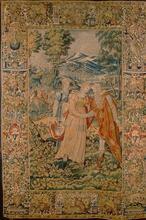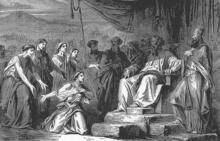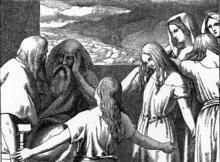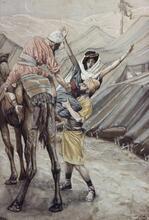Concubine of a Levite: Bible
The concubine of a Levite is likely a lesser wife, who perhaps was unfaithful and left her husband. After her husband finds her, the house in which they are staying is threatened by a group of Benjaminite men who wish to have sex with the Levite. Their host offers the concubine in the Levite’s place, which they reject; she is then thrown outside to them and they rape her until the morning, when she returns to the house and is near death. In retaliation for this act, the Israelites launch a series of attacks on the Benjaminites. The narrative of the concubine is horrifying and shows the chaos of life before monarchial rule was established.
Background of the Concubine
The story of the unnamed woman in Judges 19–20 is one of the most disturbing texts in the Hebrew Bible. The woman, who is from Bethlehem but lives with a Levite in the hill country of Ephraim, north of Jerusalem, is referred to in Hebrew as the pilegesh of the Levite. The precise nature of the relationship between a man and his pilegesh is not always clear from the biblical texts, however, and scholars have sometimes disagreed about the term’s meaning. It is usually translated into English as “concubine” and understood to refer to a wife or sexual partner of secondary status. Although certain men in the Hebrew Bible have both wives and concubines, no wives or additional concubines are referred to in Judges 19.
The Levite is referred to as the “husband” of the woman (19:3; 20:4) and the “son-in-law” of the woman’s father (19:5), who in turn is referred to as the Levite’s “father-in-law” (19:4, 7, 9). The uncertain nature of the differences between a wife and a concubine reveals the complexities involved in understanding notions of kinship and marriage presupposed by biblical narratives.
The Hebrew text states that the woman “prostituted herself against” the Levite (19:2). Thus, it has often been assumed that she was sexually unfaithful to him. Certain Greek translations, however, state that she “became angry” with him. The latter interpretation is accepted by a number of commentators and modern English translations, including the NRSV, since the woman goes to her father’s house rather than the house of a male lover. It is also possible that the woman’s “prostitution” does not refer to literal sexual infidelity but is a sort of metaphor for the fact that she leaves her husband. The act of leaving one’s husband is quite unusual in the Hebrew Bible, and the harsh language used to describe it could result from the fact that it was viewed in a very negative light.
Four months after the woman returns to Bethlehem, the Levite goes after her. Although the Hebrew text states that he wishes to “speak to her heart” (19:3; NRSV, “speak tenderly to her”), no discussion between the Levite and the woman is recounted. Indeed, the text never records any of the woman’s words. The woman’s father acts as if he is glad to see the Levite, but for several days he delays the return of the Levite and the woman to Ephraim. Because of this delay the travelers finally set out at a late hour and, due to the unwillingness of the Levite to spend the night in a city of “foreigners” (19:12), arrive at the Benjaminite city of Gibeah after the sun has gone down.
Analysis
Although hospitality to strangers was an important custom in the ancient world, the travelers initially have a difficult time finding a place to spend the night. They are finally offered hospitality by an old man who, like the Levite, is from Ephraim. While the travelers are eating, the house is surrounded by men of the city who, according to the Hebrew text, wish “to know” the Levite (19:22). “To know” is probably a euphemism for sexual intercourse here, as it is in other biblical texts and as the NRSV translates it. The Ephraimite host attempts to dissuade the men of the city from raping his male guest, offering to them his own daughter and the Levite’s concubine in place of the Levite.
Several elements in this part of the story, including the offer of two women as objects of rape in the place of a male object, are very similar to elements of the story of Lot and his daughters (Gen 19:1–8). Apparently, the sexual violation of women was considered less shameful than that of men, at least in the eyes of other men. Such an attitude reflects both the social subordination of women and the fact that homosexual rape was viewed as a particularly severe attack on male honor.
The Death of the Concubine
When the men of Gibeah refuse to accept the two women, one of the men inside the house throws the concubine outside. Interpreters generally agree that it is the Levite who throws her to the crowd, though the text only states ambiguously that “the man seized his concubine, and put her out to them” (Judg 19:25) without noting specifically which man is meant. The woman is then raped by the men of Gibeah throughout the night. They do not kill her, however, for in the morning she returns to the house from which she was thrown and collapses at the door. The Levite finds her there when he rises to leave and orders her to get up. When she does not respond, for she apparently is near death, he places her on the back of his donkey and returns to Ephraim.
The text does not tell us exactly when or how the woman dies. The Levite, upon his arrival in Ephraim, cuts the woman’s body into twelve pieces and sends these pieces throughout the land. As a result of this action, the Israelites gather at Mizpah, a traditional site of tribal assembly, to listen to the Levite’s story and plan a response to the Benjaminites. A cycle of violence ensues, resulting in the slaughter of many Benjaminite men, women, and children (20:35–48), the slaughter of most of the inhabitants of the city of Jabesh-gilead (21:8–12), and the kidnapping of young women at Shiloh (21:15–24).
It unlikely that any of the characters in this troubling tale are meant to be understood in an entirely positive light. The story is placed in a section of Judges (chaps. 17–21) illustrating the social and religious chaos that preceded the institution of Israelite kingship. The horror of the tale represents extreme disorder, to be rectified only by the establishment of monarchic rule. The fate of the concubine is particularly gruesome, however, and the story has appropriately been called a “text of terror” by one feminist commentator (Trible).
Exum, J. Cheryl. Fragmented Women: Feminist (Sub)versions of Biblical Narratives. Sheffield, England: 1993.
Frymer-Kensky, Tikva. “The Bad Old Days: Concubine and Chaos.” In Reading the Women of the Bible. Random House LLC, 2002, 118-138.
Meyers, Carol, General Editor. Women in Scripture. New York: 2000.
Milstein, Sara J. "Saul the Levite and His Concubine: The “Allusive” Quality of Judges 19." Vetus Testamentum 66, no. 1 (2016): 95-116.
Stone, Ken. “Gender and Homosexuality in Judges 19: Subject-Honor, Object-Shame?” Journal for the Study of the Old Testament 67 (1995): 87–107.
Trible, Phyllis. Texts of Terror: Literary-Feminist Readings of Biblical Narratives. Philadelphia: 1984.
Yee, Gale A. “Ideological Criticism: Judges 17–21 and the Dismembered Body.” In Judges and Method: New Approaches in Biblical Studies, edited by Gale Yee, 146–170. Minneapolis: 1995.











